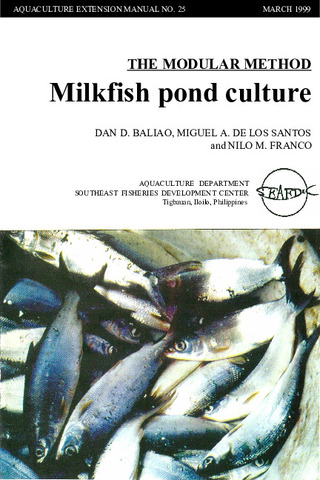Perlihatkan publikasi sederhana
Growth and production of deformed and nondeformed hatchery-bred milkfish (Chanos chanos) in brackishwater ponds
| dc.contributor.author | Sumagaysay, N. S. | |
| dc.contributor.author | Hilomen-Garcia, G. V. | |
| dc.contributor.author | Garcia, Luis Maria | |
| dc.date.accessioned | 2012-07-23T06:48:51Z | |
| dc.date.available | 2012-07-23T06:48:51Z | |
| dc.date.issued | 1999 | |
| dc.identifier.citation | Sumagaysay, N. S., Hilomen-Garcia, G. V., & Garcia, L. M. B. (1999). Growth and production of deformed and nondeformed hatchery-bred milkfish (Chanos chanos) in brackishwater ponds. The Israeli Journal of Aquaculture-Bamidgeh, 51(3), 106–113. | en |
| dc.identifier.issn | 0792-156X | |
| dc.identifier.uri | http://hdl.handle.net/10862/995 | |
| dc.description.abstract | This study evaluated the growth and survival of morphologically deformed and nondeformed hatchery-bred milkfish in brackishwater ponds. It compared the size-frequency distribution of the nondeformed fish with the deformed ones, and determined the effects of different types of deformity on growth. The deformities include the absence of an upper jaw, a folded operculum with gills exposed, a cleft branchiostegal membrane, scoliosis, etc. The results were compared with production of wild stock. Hatchery-bred and wild milkfish fry were grown separately in nursery ponds (500 m2/pond) at 10 individuals/m2. After a month, the juveniles (average weight hatchery-bred 6.0 g; wild 9.5 g) were transferred to seven rearing ponds of 1000 m2 each (stocking density 3000/ha). Three ponds were stocked with selected, nondeformed hatchery-bred fish (unmixed stock), three ponds with a combination of deformed and nondeformed hatchery-bred fish (1:2 ratio; mixed stock), and one pond with wild fish. The final weight, specific growth rate and survival of the nondeformed fish (mixed and unmixed stock) after four months of culture were significantly higher (p<0.05) than those of the deformed fish. Production, however, did not significantly differ between the unmixed nondeformed (433 kg/ha) and the mixed deformed and nondeformed (377 kg/ha) fish. Survival of the deformed stock (56%) was significantly lower (p<0.05) than that of the nondeformed stock (86-88%). Approximately 92% of the deformed stock and 17-20% of the nondeformed were below 150 g. Severe deformities such as the absence of an upper jaw and exposure of all or most of the gills hindered fish growth, while widening of the operculum or branchiostegal membrane, scoliosis, or absence of the anal fin had less effect on growth. To lower the incidence of deformities in grow-out ponds, milkfish fry should be reared to the early juvenile stage in nursery ponds for at least a month. The harsh natural conditions in the nursery ponds (e.g., presence of predators, abrupt changes in salinity, temperature and dissolved oxygen) and stress during transfer to rearing ponds may eliminate most of the weak fish and those with severe deformities. | en |
| dc.language.iso | en | en |
| dc.publisher | Society of Israeli Aquaculture and Marine Biotechnology | en |
| dc.subject | Chanos chanos | en |
| dc.subject | milkfish | en |
| dc.title | Growth and production of deformed and nondeformed hatchery-bred milkfish (Chanos chanos) in brackishwater ponds | en |
| dc.type | Article | en |
| dc.citation.volume | 51 | |
| dc.citation.issue | 3 | |
| dc.citation.spage | 106 | |
| dc.citation.epage | 113 | |
| dc.citation.journalTitle | The Israeli Journal of Aquaculture-Bamidgeh | en |
| dc.subject.asfa | malformations | en |
| dc.subject.asfa | stress | en |
| dc.subject.asfa | fish culture | en |
| dc.subject.asfa | mortality causes | en |
| dc.subject.asfa | salinity effects | en |
| dc.subject.asfa | stocking density | en |
| dc.subject.asfa | survival | en |
| dc.subject.scientificName | Chanos chanos |
Files in this item
| Files | Size | Format | View |
|---|---|---|---|
|
There are no files associated with this item. |
|||
Publikasi ini ada di koleksi berikut
-
Journal Articles [1258]
These papers were contributed by Department staff to various national and international journals.



